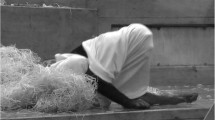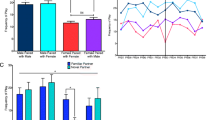Abstract
The urge for physical play in mammals, including humans, is built into the nervous system (Panksepp, 2008). This has been rigorously demonstrated in laboratory animals (Ikemoto & Panksepp, 1992). Although the precise functions of physical play remain unspecified, it is likely essential for optimal childhood development, both body and mind, with many demonstrated benefits (Burgdorf, Kroes, Beinfeld, Panksepp, & Moskal, 2010; Panksepp, 1993, 2010). We propose that play forms the backbone of young children’s daily life through spontaneous social learning that enhances social interactions, promotes learning, and provides positive affect that may increase psychological resilience. In fact, we now know that play provides considerable benefits in young animals, where the necessary detailed behavioral work can be done (as summarized in Burgdorf et al., 2010; Burgdorf, Panksepp, & Moskal, 2011; Gordon, Burke, Akil, Watson, & Panksepp, 2003; Panksepp, Siviy, & Normansell, 1984; Pellis & Pellis, 2009; Vanderschuren, 2010).
Access this chapter
Tax calculation will be finalised at checkout
Purchases are for personal use only
Similar content being viewed by others
References
Aldis, O. (1975). Play fighting. New York: Academic.
American Psychiatric Association. (1994). Diagnostic and statistical manual of mental disorders (4th ed.). Washington, D.C.: American Psychiatric Association.
Barkley, R. A. (1997). ADHD and the nature of self-control. New York: Guilford.
Bekoff, M., & Byers, J. A. (1998). Animal Play: evolutionary, comparative, and ecological perspectives. New York: Cambridge University Press.
Bertrand, M. (1976). Rough-and-tumble play in stumptails. In J. S. Bruner, A. Jolly, & K. Sylva (Eds.), Play—its role in development and evolution (pp. 320–327). New York: Basic.
Blurton-Jones, N. (1972). Categories of child-child interaction. In N. Blurton- Jones (Ed.), Ethological studies of child behavior (pp. 97–129). New York: Cambridge University Press.
Blurton-Jones, N. (1976). Rough-and-tumble play among nursery school children. In J. S. Bruner, A. Jolly, & K. Sylva (Eds.), Play—its role in development and evolution (pp. 352–363). New York: Basic.
Bornstein, M. H., Haynes, O. M., Pascual, L., Painter, K. M., & Galperin, C. (1999). Play in two societies: pervasiveness of process, specificity of structure. Child Development, 70, 317–331.
Boulton, M. J. (1991a). A comparison of structural and contextual features of middle school children’s playful and aggressive fighting. Ethology and Sociobiology, 12, 119–145.
Boulton, M. J. (1991b). Partner preferences in middle school children’s playful fighting and chasing. Ethology and Sociobiology, 12, 177–193.
Boulton, M. J. (1993). Children’s abilities to distinguish between playful and aggressive fighting: a developmental perspective. British Journal of Developmental Psychology, 11, 249–263.
Boulton, M. J. (1996). A comparison of 8- and 11-year-old girls’ and boys’ participation in specific types of rough-and-tumble play and aggressive fighting: Implications for functional hypothesis. Aggressive Behavior, 22, 271–287.
Boulton, M. J., & Smith, P. K. (1992). The social nature of play fighting and play chasing: mechanisms and strategies underlying cooperation and compromise. In J. H. Barkow, L. Cosmides, & J. Tooby (Eds.), The adapted mind: evolutionary psychology and the generation of culture (pp. 429–449). New York: Oxford University Press.
Burgdorf, J., Kroes, R. A., Beinfeld, M. C., Panksepp, J., & Moskal, J. R. (2010). Uncovering the molecular basis of positive affect using rough-and-tumble play in rats: a role for insulin-like growth factor I. Neuroscience, 168, 769–777.
Burgdorf, J., Panksepp, J., & Moskal, J. R. (2011). Frequency-modulated 50 kHz ultrasonic vocalizations: a tool for uncovering the molecular substrates of positive affect. Neuroscience & Biobehavioral Reviews, 35, 1831–1836.
Burgdorf, J., Wood, P. L., Kroes, R. A., Moskal, J. R., & Panksepp, J. (2007). Neurobiology of 50-kHz ultrasonic vocalizations in rats: electrode mapping, lesion, and pharmacology studies. Behavioral Brain Research, 182, 274–283.
Burghardt, G. M. (2005). The genesis of animal play. Cambridge, MA: MIT.
Byers, J. A., & Walker, C. (1995). Refining the motor training hypothesis for the evolution of play. American Naturalist, 146, 25–40.
DiPietro, J. A. (1981). Rough and tumble play: a function of gender. Developmental Psychology, 17, 50–58.
Erikson, E. H. (1950). Childhood and society. New York: W.W. Norton.
Fagen, R. (1981). Animal play behavior. New York: Oxford.
Frost, J. L., Wortham, S., & Reifel, S. (2001). Play and child development. Upper Saddle River, NJ: Merrill Prentice Hall.
Fry, D. P. (1987). Difference between play fighting and serious fighting among zapotec children. Ethology and Sociobiology, 8, 285–306.
Gandelman, R. (1992). Play: The psychobiology of behavioral development. (Monogragh) New York: Oxford University Press.
Gilmore, J. B. (1971). Play: a special behavior. In R. E. Herron & B. Sutton-Smith (Eds.), Child’s play (pp. 311–325). New York: Wiley.
Gordon, N. S., Burke, S., Akil, H., Watson, J., & Panksepp, J. (2003). Socially induced brain fertilization: play promotes brain derived neurotrophic factor expression. Neuroscience Letters, 341, 17–20.
Groos, K. (1898). The play of animals. New York: D. Appleton.
Howes, C., & Matheson, C. (1992). Sequence in the development of competent play with peers: social and pretend play. Developmental Psychology, 28, 961–974.
Humphreys, A., & Smith, P. (1984). Rough-and-tumble in preschool and playground. In P. K. Smith (Ed.), Play in animals and humans (pp. 241–270). London, UK: Blackwell.
Humphreys, A., & Smith, P. (1987). Rough-and-tumble, friendship, and dominance in school children: Evidence for continuity and change with age. Child Development, 58, 201–212.
Ikemoto, S., & Panksepp, J. (1992). The effects of early social isolation on the motivation for social play in juvenile rats. Developmental Psychobiology, 25, 261–274.
Kagan, J., Reznick, J. S., & Snidman, N. (1987). The physiology and psychology of behavioral inhibition in children. Child Development, 58, 1459–1473.
Louv, R. (2008). Last child in the woods: saving our children from nature-deficit disorder. Chapel Hill, NC: Algonquin Books of Chapel Hill.
Maccoby, E. E. (1997). Gender and relationships: a developmental account. American Psychologist, 45, 513–520.
Maccoby, E. E., & Jacklin, C. N. (1987). Gender segregation in childhood. In H. W. Reese (Ed.), Advances in child development and behavior (Vol. 20, pp. 239–288). New York: Academic.
McGrew, W. C. (1972). An ecological study of children’s behaviour. London, UK: Academic.
Meaney, M. J., & Stewart, J. (1981). Neonatal androgens influence the social play of prepubescent rats. Hormones and Behavior, 15, 197–213.
Mol Lous, A., de Wit, C. A., De Bruyn, E. E., & Riksen-Walraven, J. M. (2002). Depression markers in young children’s play: a comparison between depressed and nondepressed 3- to 6-year-olds in various play situations. Journal of Child Psychology and Psychiatry, 43, 1029–1038.
Panksepp, J. (1980). The ontogeny of play in rats. Developmental Psychobiology, 14, 327–332.
Panksepp, J. (1993). Rough and tumble play: a fundamental brain process. In K. McDonald (Ed.), Parent-child play: description and implications (SUNY series, Children’s Play in Society, pp. 147–184). Albany, New York: State University of New York Press.
Panksepp, J. (1998a). Affective neuroscience. New York: Oxford University Press.
Panksepp, J. (1998b). The quest for long-term health and happiness: to play or not to play, that is the question. Psychological Inquiry, 9, 56–66.
Panksepp, J. (2007a). Can PLAY diminish ADHD and facilitate the construction of the social brain. Journal of the Canadian Academy of Child and Adolescent Psychiatry, 10, 57–66.
Panksepp, J. (2007b). Neuroevolutionary sources of laughter and social joy: modeling primal human laughter in laboratory rats. Behavioral Brain Research, 182(2), 231–244.
Panksepp, J. (2008). PLAY, ADHD and the construction of the social brain: Should the first class each day be recess? American Journal of Play, 1, 55–79.
Panksepp, J. (2010). Science of the brain as a gateway to understanding play: An interview with Jaak Panksepp. American Journal of Play, 2, 145–277.
Panksepp, J., & Beatty, W. W. (1980). Social deprivation and play in rats. Behavior and Neural biology, 30, 197–206.
Panksepp, J., Burgdorf, J., & Gordon, N. (2003). Modeling ADHD-type arousal with unilateral frontal cortex damage in rats and beneficial effects of play therapy. Brain and Cognition, 52, 97–105.
Panksepp, J., Normansell, L., Cox, J. F., & Siviy, S. M. (1994). Effects of neonatal decortication on the social play of juvenile rats. Physiology & Behavior, 56, 429–443.
Panksepp, J., Siviy, S., & Normansell, L. (1984). The psychobiology of play: theoretical and methodological perspectives. Neuroscience & Biobehavioral Reviews, 8, 465–492.
Pellegrini, A. D. (1984). The social cognitive ecology of preschool children. International Journal of Behavioral Development, 7, 321–332.
Pellegrini, A. D. (1987). Rough-and-tumble play: developmental and educational significance. Educational Psychologist, 22, 23–43.
Pellegrini, A. D. (1988a). Elementary-school children’s rough-and-tumble play and social competence. Developmental Psychology, 24, 802–806.
Pellegrini, A. D. (1988b). What is a category? The case of rough-and-tumble play. Ethology and Sociobiology, 10, 331–341.
Pellegrini, A. D. (1989a). Elementary school children’s rough-and-tumble play. Early Childhood Research Quarterly, 4, 245–260.
Pellegrini, A. D. (1989b). Categorizing children’s rough-and-tumble play. Play and Culture, 2, 48–51.
Pellegrini, A. D. (1992). Rough-and-tumble play and social problem solving flexibility. Creativity Research Journal, 5, 13–26.
Pellegrini, A. D. (1993). Boys’ rough-and-tumble play, social competence and group composition. British Journal of Developmental Psychology, 11, 237–248.
Pellegrini, A. D., & Smith, P. K. (1998). Physical activity play: the nature and function of a neglected aspect of play. Child Development, 69, 577–598.
Pellis, S., & Pellis, V. (2009). The playful brain: venturing to the limits of neuroscience. Oxford, UK: Oneworld.
Piaget, J. (1962). Play, dreams and imitation in childhood. New York: W.W. Norton.
Potegal, M., & Einon, D. (1989). Aggressive behaviors in adult rats deprived of playfighting experience as juveniles. Developmental Psychobiology, 22, 159–172.
Power, T. G. (2000). Play and exploration in children and animals. Mahwah, NJ: Lawrence Erlbaum Associates.
Scott, E. (2001). Toward a play program to benefit children’s attention in the classroom. Unpublished Ph.D. Dissertation. Bowling Green State University, Bowling Green, OH.
Scott, E., & Panksepp, J. (2003). Rough-and-tumble play in human children. Aggressive Behaviour, 29, 539–551.
Siviy, S. M., & Panksepp, J. (2011). In search of the neurobiological substrates for social playfulness in mammalian brains. Neuroscience and Biobehavioral Reviews, 35, 1821–1830.
Smith, P., & Boulton, M. (1990). Rough-and-tumble play, aggression and dominance: perception and behavior in children’s encounters. Human Development, 33, 271–282.
Smith, P. K., & Connolly, K. J. (1980). The ecology of preschool behavior. Cambridge, UK: Cambridge University Press.
Smith, P. K., & Hagan, T. (1980). Effects of deprivation on exercise play in nursery school children. Animal Behavior, 28, 922–928.
Smith, P. K., & Lewis, K. (1985). Rough-and-tumble play, fighting, and chasing in nursery school children. Ethology and Sociobiology, 6, 175–181.
Sumpner, C., & Blatchford, P. (1998). What do we know about breaktime? Results from a national survey of breaktime and lunchtime in primary and secondary schools. British Educational Research Journal, 24, 79–94.
Sutton-Smith, B., & Kelly-Byrne, D. (1984). The phenomenon of bipolarity in play theories. In B. Sutton-Smith & D. Kelly-Byrne (Eds.), Child’s play: developmental and applied (pp. 29–47). New Jersey: Lawrence Erlbaum.
Talmadge, J., & Barkley, R. A. (1983). The interactions of hyperactive and normal boys and their fathers and mothers. Journal of Abnormal Child Psychology, 11, 565–580.
van den Berg, C. L., Hol, T., Van Ree, J. M., Spruijt, B. M., Everts, H., & Koolhaas, J. M. (1999). Play is indispensable for an adequate development of coping with social challenges in the rats. Developmental Psychobiology, 34, 129–138.
Vanderschuren, L. J. M. J. (2010). How the brain makes play fun. American Journal of Play, 2, 315–337.
Author information
Authors and Affiliations
Corresponding author
Editor information
Editors and Affiliations
Rights and permissions
Copyright information
© 2012 Springer Science+Business Media New York
About this chapter
Cite this chapter
Panksepp, J., Scott, E.L. (2012). Reflections on Rough and Tumble Play, Social Development, and Attention-Deficit Hyperactivity Disorders. In: Meyer, A., Gullotta, T. (eds) Physical Activity Across the Lifespan. Issues in Children's and Families' Lives, vol 12. Springer, New York, NY. https://doi.org/10.1007/978-1-4614-3606-5_2
Download citation
DOI: https://doi.org/10.1007/978-1-4614-3606-5_2
Published:
Publisher Name: Springer, New York, NY
Print ISBN: 978-1-4614-3605-8
Online ISBN: 978-1-4614-3606-5
eBook Packages: Behavioral ScienceBehavioral Science and Psychology (R0)




